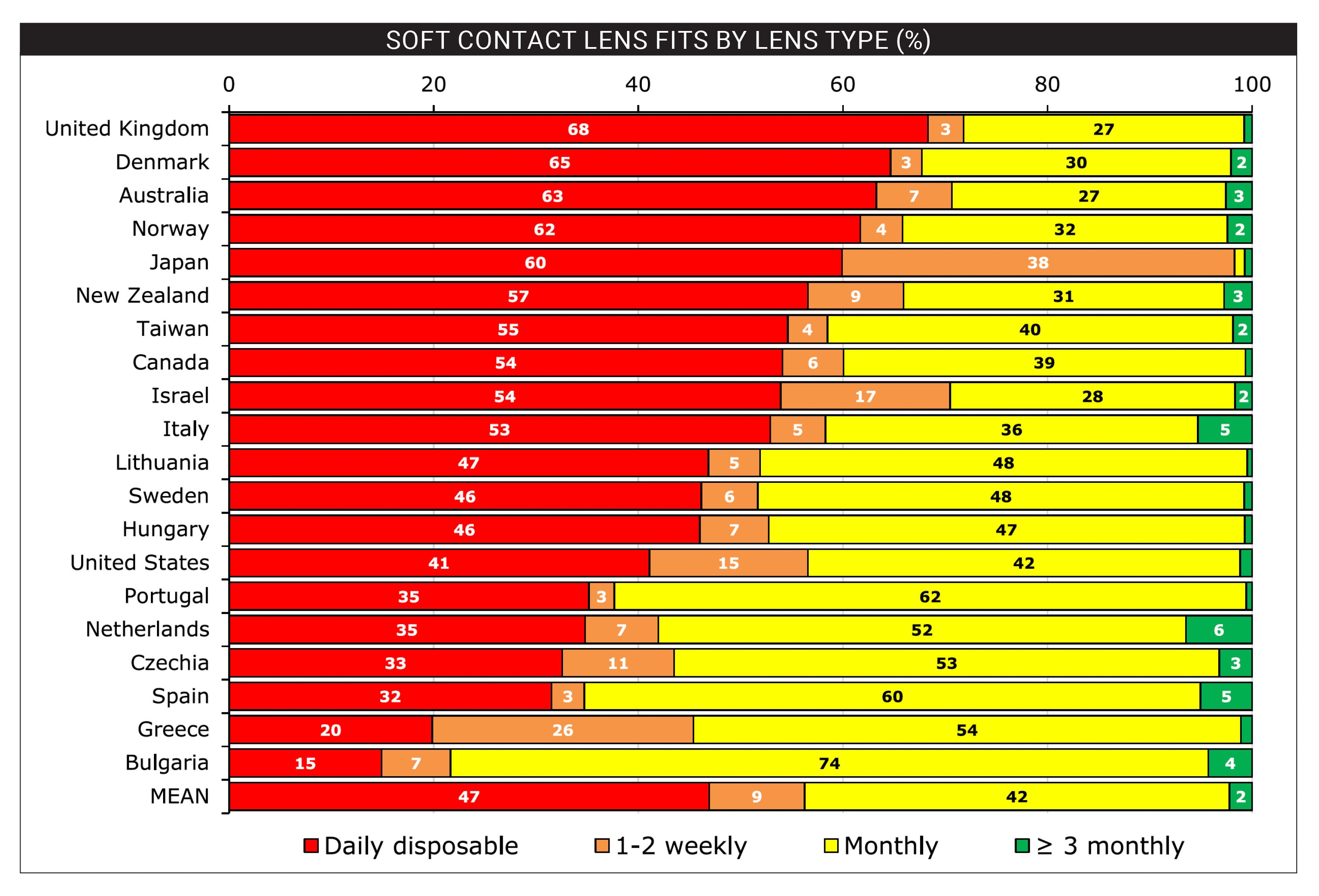Daily disposable soft contact lenses offer maximum convenience by eliminating lens cleaning, maintenance and overnight storage hassles and reduce frustrations about less loss or damage by giving wearers ample inventory. A recent study in Contact Lens & Anterior Eye extended previous reports on contact lens prescribing trends globally from 1996 and 2011. The researchers’ update on daily disposable contact lens prescribing to 2023 noted an accelerated increase over the past 20 years.
An annual contact lens prescribing survey was sent to eyecare practitioners in up to 71 countries between 2000 and 2023. Data relating to 265,106 daily wear soft lens fits that were undertaken in 20 countries that returned reliable longitudinal data were analyzed in respect of daily disposable lens fitting.
 |
| The researchers noted that the increase in daily disposable lens fitting was not instantaneous after its introduction in the mid-1990s; rather, it was a slow and steady increase, at least over the 24-year span of this survey. Significant differences in uptake of the modality exist between countries. Photo: Morgan PB, et al. Cont Lens Ant Eye. June 24, 2024. Click image to enlarge. |
Overall, daily disposable lens prescribing increased over time, from 17.1% of daily wear soft lens fits in 2000 to 46.7% in 2023. There were significant differences between countries in daily disposable lens prescribing (see chart) and between the percentage of male patients fitted with daily disposables as a proportion of all daily wear soft lenses (37.2%) compared with female patients (35.2%). Daily disposable wearers were slightly younger at fitting than reusable soft lens wearers (31.0 vs. 31.2 years, respectively), although this difference was not clinically meaningful. Analysis of 50,240 daily wear soft lenses fitted recently (2019 to 2023) was found to be prescribed for the following replacement frequencies: daily (47%); monthly (42%); every one or two weeks (9%); and ≥every three months (2%).
“The driving force for the evolution towards more frequent soft lens replacement was the growing body of evidence suggesting that more regular lens replacement offered better visual performance, enhanced anterior eye physiology and improved ocular health,” the researchers wrote in their paper.
The team noted that overall success of daily disposable lenses was likely due to multiple factors. Daily disposable lens wear can eliminate care solution-related problems and significantly reduce the risk of developing corneal infiltrative events. Fewer ocular complications in general have been reported with daily disposable lenses compared with reusable lenses. Also, eyecare practitioners could maintain an inventory of daily disposable lenses that could help facilitate timely and accurate lens fitting, as well as the immediate dispensing of lenses for short-term wearing trials, prior to offering an ongoing lens supply.
A primary factor contributing to differences between nations in the extent of daily disposable lens prescribing was the perceived and actual higher cost of this lens type for full-time wearers. There was a significant positive relationship between the proportion of daily disposable lenses prescribed and national GDP per capita at purchasing power parity—essentially a measure of national affluence. Lens wearers in low-GDP countries may be less able to afford daily disposable lenses and instead opt for less expensive reusable lenses.
The researchers also commented on the fact that daily disposable lens prescribing was particularly strong in certain countries, such as the United Kingdom and Denmark, because these nations were ‘test beds’ for some of the early clinical trials of daily disposable lenses and benefited from early local product releases.
“Such activity is likely to have heightened practitioner interest and enthusiasm, resulting in a greater propensity for practitioners in these nations to prescribe daily disposable lenses,” they wrote.
A comparable report from the same group delves into trends in rigid lens wear. You can read our report on that paper here.
Morgan PB, Efron N, Woods CA, et al. International trends in daily disposable contact lens prescribing (2000–2023): an update. Cont Lens Anterior Eye. June 30, 2024. [Epub ahead of print]. |


